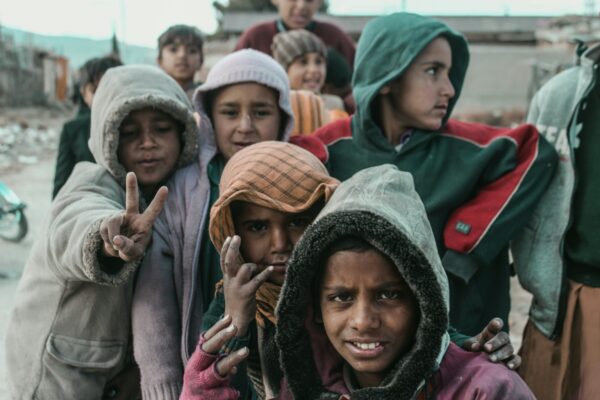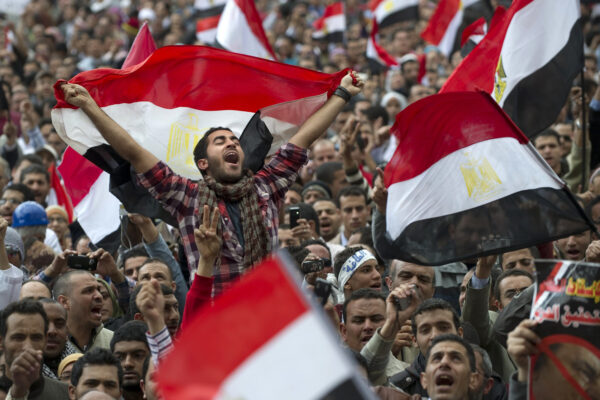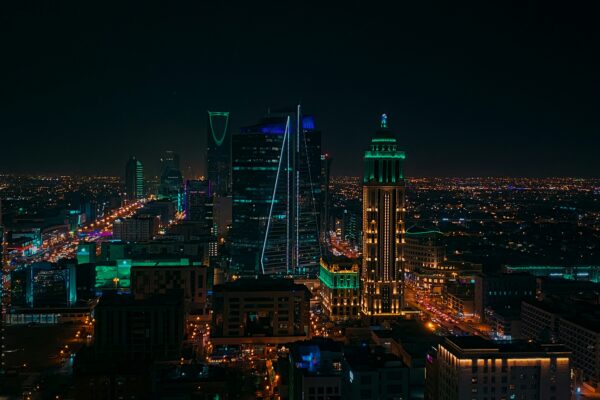By occupying the Pearl Roundabout, we not only witness the change in its meaning and what it represents, but we also witness the emergence of multiple spaces, such as the political and the civic, that challenge the legitimacy and hegemony of the state over its citizens.
By occupying the Pearl Roundabout, we not only witness the change in its meaning and what it represents, but we also witness the emergence of multiple spaces, such as the political and the civic, that challenge the legitimacy and hegemony of the state over its citizens.
In the wave of uprisings that stormed the Arab world, known as the Arab Spring, Bahrain’s uprising was and still is the most overlooked case.
The meagerness of thought-provoking books and scholarly articles that dissect Bahrain’s uprising illustrates the disregard attributed to the 2011 Bahraini uprising. As a result, a meaningful and detailed study of the uprising ought to be preceded by a brief historical overview to contextualize the 2011 uprising.
The aim of this article, therefore, is to demonstrate the importance of public space in the Bahraini uprising. The contestation of public space between the protestors and the state was a central theme of the uprising.
The non-violent nature of the uprising in occupying important public spaces gave the movement immense popularity within Bahrain. The importance of the Pearl Roundabout, the space occupied by the peaceful protestors, ought to be examined because of its relevance to state power and ideology.
During the uprising, the meaning behind the Pearl Roundabout and the symbol it represented in favor of the status quo was overshadowed by the values and demands of the protestors – and changing the meaning of the Pearl Roundabout in favor of the protestors epitomized the contestation over public space in Bahrain’s uprising.
After highlighting the shift in the meaning of the Pearl Roundabout, the article will shed light on the government’s response to the continued occupation of the Pearl Roundabout by the protestors. The brutality deployed by the government along with the destruction of the Pearl Roundabout cemented the importance of public space for the preservation of the status quo.
In the same realm, sectarianizing public space was a strategy utilized by state authorities to discredit the peaceful protestors and their demands. As evident from the brief introduction, contesting public space became a dominant struggle during the uprising. Therefore, the contestation of public space through non-violent resistance was a strategy employed by the protestors in the 2011 Bahraini uprising, before the government unleashed force to restore its hegemony on public space and political discourse.
The Origin of the Pearl Roundabout
Before dissecting the revolutionaries’ occupation of the Pearl Roundabout, it is important to understand the history of the roundabout and the image it represented prior to the uprising.
The Pearl monument was erected on a roundabout in the capital, Central Manama which is known for its strategic economic and cultural importance. The Pearl monument consists of six white sails with a pearl at the top. The six white sails represent GCC member states: Bahrain, Saudi Arabia, Kuwait, Oman, UAE, and Qatar. The pearl represents the region’s pearl diving economy which was no longer significant by the end of the 20th century.
The monument was built in 1982 before the third GCC summit in Bahrain. The GCC member states, fearing the “Iranian encroachment”, invested immensely in defense to provide collective protection for the member states.
The subsequent military or security partnership that was created between the GCC states came to be known as the Peninsula Shield Force or “Dr’a al Jazeera.” Thus, the newly established monument represented the preservation of the status quo, the Al-Khalifa, through agreements with the neighboring countries.
But what is the connection between public space, power, and the people? It is in public space that the government conveys itself to the people. Through monuments, statues, or buildings the government presents itself as a dominant, omnipresent, and righteous authority over the people.
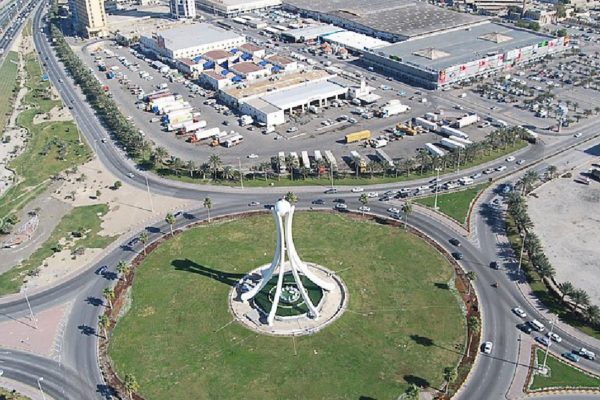
In his book, The Power and the People: Paths of Resistance in the Middle East, Charles Tripp emphasizes the importance of public spaces for the government because it is a space in which the government projects its power and hegemony. He states: “Here, the daunting state institutions form the built environment of power, presenting an edifice of seemingly solid material weight. . . designed as both the repositories and the projections of power.”
In the case of Bahrain, the Pearl Roundabout not only presents the ruling family as the rightful authority, but it also presents the Al-Khalifa as the preserver of Bahrain’s history and heritage. Given the diversity within Bahrain’s tiny population of 1.7 million (Arab Sunnis, Persian Sunnis, Arab Shi’as, and Persian Shi’as), Al-Khalifa also alienated a large proportion of the population by presenting itself as the traditional, authentic, and indigenous Arab (Sunni) protector of Bahraini soil.
In presenting itself as the representative of the nation, any threat to the ruling family’s grip on power is equivalent to undermining Bahrain’s sovereignty and independence. More importantly, affection and commitment to Bahrain’s soil are synonymous with affection and commitment towards the ruling family. Owing to its significant meaning in favor of the status quo, the Pearl Roundabout was printed on coins.
The Pearl Roundabout cements the legitimacy of the Al-Khalifa as the authentic Arab Sunni rulers, by also erasing the prominence of Safavid history and Bahrain’s considerable Shi’a and Persian population. Because of the symbols that this monument represented regarding the rightful guardianship of the Al-Khalifa, it became the main target of the peaceful protestors that sought to challenge and alter the image that was created by the state.
Public space contestation is present wherever the government has publicly, through edifices or monuments, displayed its hegemony and power. As Michel Foucault famously stated, “Wherever there is power, there is resistance.”
Because of their accessibility to the public as open areas, the people seek to assert their claims on the space by rejecting and challenging the state narrative. As it pertains to Bahrain, the Pearl Roundabout was an open area public space and was easily accessible, making it a hub for contestation, rejection, and confrontation with the state.
The Pearl Roundabout in The Context of The 2011 Uprising
During the 2011 uprising, the Pearl Roundabout became the epicenter of demonstrations. Because the Pearl Roundabout embodied the state in a positive light, the protestors unleashed their anger and discontent at this space.
The protestors sought to distort the image that was associated with this space, in other words, they were vigorously contesting the meaning that this space held. Defying authority in these spaces is important because not only does it distort the image created by the state, but it also gives popularity and legitimacy to the protests.
Author Charles Tripp again states: “By resisting the ways in which government demands conformity. . . and by challenging its control over space, opposition can make its cause and its presence felt. It gives the lie to the picture that the authorities wish to project of an orderly society, respectful of power and of the public institutions of the state.”
In addition, Tripp also maintains that public defiance of authority mobilizes the people by uniting them around a cause that is relatable and popular. The Pearl Roundabout was a space in which the government displayed its face, and during the uprising, it became a space where the people sounded their discontent with the government and defied state structures. Therefore, in the nascent stages of the uprising, altering and redefining the meaning of the Pearl Roundabout was underway.
Furthermore, the Pearl Roundabout had a transnational significance since it represented the other five GCC member states. The protests, as a result, not only defied the state, but they also rejected the GCC ties because the people believed that the GCC ties sustained the ruling families at the expense of the people.
This belief was later manifested when Saudi forces crossed the King Fahad Causeway (connecting Saudi with Bahrain) and intervened with the blessing of the Al-Khalifa to crush the protests. Thus, the confrontation was not only against the Bahraini government, but the protestors were also vehemently opposed to the GCC governments that helped sustain the Al-Khalifa.
The protestors viewed the Emirati and Saudi governments, in particular, as the main transnational adversaries. Since the beginning of the uprising on 14th February 2011, the Pearl monument no longer represented GCC unity for it became a site for challenging the legitimacy and popularity of the ruling family.
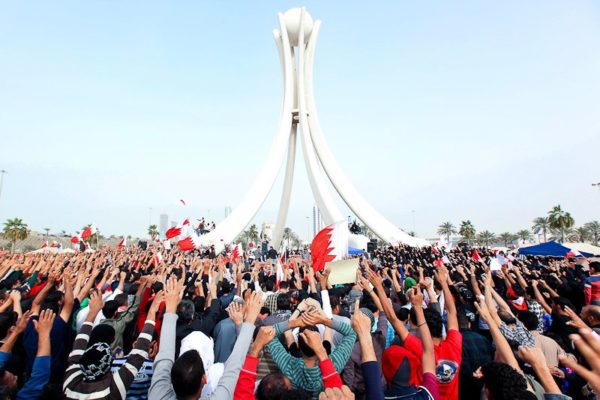
Inspired by the Egyptian and Tunisian uprisings and driven by decades of oppression and injustice, the people of Bahrain set February 14th as the day of rage to protest. The 14th of February holds significance in Bahrain’s context because it is the anniversary of the National Action Charter, in which the government has promised a set of political and economic reformations.
One of the most important demands that the people had when they announced the 14th of February as the day of rage was the cessation of tajnis, naturalization. This is important in Bahrain’s case because, given the clear Shi’a majority, the Sunni ruling family was and still is naturalizing Sunnis from different parts of the Muslim world to increase the Sunni demographics in the country.
Bahrainis often joke about the prevalent scheme of naturalization, saying “. . . you can expect to be arrested by a Pakistani, interrogated by a Jordanian, tortured by a Yemeni, and judged by an Egyptian, but at least you can expect your fellow prisoners to be Bahraini.” Naturalization for the people was a repressive tool that needed to be abolished.
However, the demands also required extensive reformation of government policies coupled with a radical overhaul of state structures that would prioritize the needs of the citizens vis-a-vis the ruling family’s wealth accumulation.
Although these demands are important for understanding the Bahraini uprising, one might not necessarily see its importance in the context of public space contestation. Therefore, it is significant to link the people’s demands with the space in which they sounded them.
The people occupied the Pearl Roundabout and made it the headquarters of their protests. It was in this space that the people revealed their demands. The Pearl Roundabout became the space in which the people contested the authority by demanding radical reformation. As a result, the link between people’s demands and the Pearl monument is a direct one.
More importantly, the Pearl Roundabout became the space in which the shackles of fear were publicly broken. Before the uprising, it would be fear and isolation that would restraint the people from demanding dignity and accountability from the status quo. With the uprising, the barriers to unity and mobilization were struck down.
By occupying the Pearl Roundabout, we not only witness the change in its meaning and what it represents, but we also witness the emergence of multiple spaces, such as the political and the civic, that challenge the legitimacy and hegemony of the state over its citizens.
Due to the continuous occupation of the Pearl Roundabout along with the political and civic engagements that took place on its premises, it no longer emblematized the supremacy of Al-Khalifa’s authority or GCC unity. Rather it symbolized bravery in the face of brute force, dignity in the face of dehumanization, and freedom in the face of suppression. The Pearl Roundabout suddenly became a symbol revealing the tyranny of the GCC states that supported Al-Khalifa, but most importantly, it became a threat to the ruling family’s grip on power.
The threat that the Pearl monument poses to the status quo becomes obvious by dissecting the government’s response to the continued occupation of the Pearl Roundabout.
The Government’s Response: Demolishing, Erasing, and Sectarianizing Public Space
The manner in which the government responded or countered the protestor’s continuous occupation of the Pearl Roundabout proves the success of the people in altering the meaning of the Pearl Roundabout. In addition, the mistrust of the authorities along with the animosity towards GCC ruling families (especially Saudi) was displayed during the uprising.
After murdering countless protestors, the government realized its weakness in countering the protestors and swiftly welcomed Saudi intervention along with Emirati support. Although the protests were peaceful and non-violent, the government could not defeat its popularity by force.
It is pertinent to point out that the protestors continuously prioritized non-violent resistance. The protestors’ non-violent approach, however, did not prevent the Saudi forces from attacking the Pearl Roundabout and expelling the protestors. Following the expulsion of demonstrators from the Pearl monument, the government sought to demolish and erase any trace of revolutionary symbolism.
Directly after the Saudi intervention and the brutal attack on the protestors at the roundabout, the government prioritized the demolishment of the most powerful revolutionary symbol, the Pearl Roundabout. The Pearl Roundabout stood high as a symbol and icon of national resistance to the ruling family and to GCC ties. The takeover of the Pearl Roundabout closed free public spaces, civil spaces, and political spaces.
The government demolished the Pearl monument because of the threat it posed to the status quo. Thus, this shift in what the monument came to represent establishes the fact that the monument had become a foe of the state, and “Its punishment was erasure.”
Nevertheless, the government deployed another tactic, sectarianizing public space, to counter the ubiquitous memory of the uprising. In seeking to discredit the protestors and their demands, the state accused them of being Iranian agents that are seeking to establish an Islamic Republic. Divide and rule tactics were utilized to weaken and discredit the popularity of the protests.
In doing so, many Sunnis were reluctant to support the 2011 uprising because of its alleged ‘foreign element’ or it being ‘exclusively Shi’a’. Labeling the protestors and their cause as sectarian and foreign plays an immense role in legitimizing the destruction of the Pearl roundabout and in giving the newly demolished space a sectarian and inflammatory name.
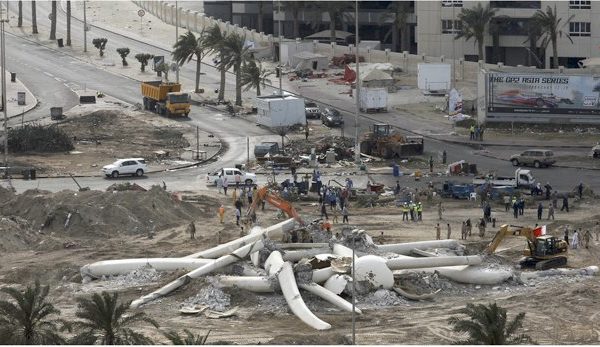
Before turning to the sectarianizing of public space, it is important to note that Iran was not involved in the 2011 uprising. The fabrication of the “Iranian” or “sectarian” nature of the movement was deployed to demonize the protestors. In addition, classified documents by the US embassy in Bahrain debunks any myth of Iranian involvement in the Bahraini uprisings. Also, the ruling family has not put forth any evidence confirming its claims.
However, the Bahraini government continues to blame unrest in the country on Iran. This is important in the context of space contestation because it allows the state to respond in a sectarian and authoritarian manner. To galvanize the Sunnis and to divide the population, the state named the space that once housed the Pearl Roundabout, Al Farooq Junction.
Farooq is a reference to the second Caliph Umar ibn al-Khattab, and a personality that is not very favorable in the view of the Shi’a due to their belief that Ali, the son in law of the Prophet and the first man to embrace Islam, was appointed as the successor of the Prophet on the event known as Ghadir. Therefore, Al Farooq Junction cemented the divisive sectarian claim of the uprisings while ensuring Sunni loyalty to the authorities at the expense of the Shi’as.
The status quo not only contested the space by demolishing the monument that represented the 2011 uprising, but by also sectarianizing the space through giving it a provocative name. This incendiary label was also contested by the demonstrators.
Despite the erasure of the Pearl monument, anti-government forces labeled the space, Martyr’s Square or Midan al Shuhada. Hence, the contestation and confrontation over public space is still an ongoing conflict, despite the crushing of the 2011 Bahraini uprising.
Conclusion
Public space contestation was a vital theme before, during, and after the Bahraini uprising. Before the uprising, the Pearl monument represented the legitimacy, hegemony, and authenticity of the ruling family. During the uprising, however, it represented the revolutionary cause that was based on dignity and freedom.
In addition, during the uprising it represented the weakness and illegitimacy of the state by giving birth to an alternative political and civic space, challenging the structures of the state. The contestation of public space has continued following the expulsion of the protestors by governmental and Saudi forces. This was evident through the demolishment of the Pearl monument and through renaming the space provocatively, al-Farooq Junction.
On the people’s side, however, despite its demolishment, the Pearl remains the emblem of revolution and resistance, and this is embodied by naming the space Midan al Shuhada. Thus, the Pearl Roundabout was subjected to the death penalty because it betrayed its initial promise in solidifying and publicizing the legitimacy of the Al-Khalifa.
Today, the contestation is no longer between defining or representing the Pearl Roundabout, for its commitment is explicitly towards the revolutionary cause. Rather the conflict today is between the preservation and the erasure of revolutionary, anti-status quo emblems from all influential platforms, especially social media.
Bibliography
Jadaliyya. “Pearl No More: Demolishing the Infrastructure of Revolution.” Jadaliyya. Jadaliyya, June 10, 2017. https://www.jadaliyya.com/Details/23814.
Nebil Husayn. “Mechanisms of Authoritarian Rule in Bahrain.” Arab Studies Quarterly, vol. 37, no. 1, 2015, pp. 33–53. JSTOR, www.jstor.org/stable/10.13169/arabstudquar.37.1.0033. Accessed 23 Apr. 2021.
Shehabi, Ala’a, and Marc Owen Jones. Bahrain’s Uprising: Resistance and Repression in the Gulf. Zed Books, 2015.
Solomon, Erika. “Bahrain’s Unseen Protests Fall on Deaf Ears.” Reuters. Thomson Reuters, June 9, 2011. https://www.reuters.com/article/oukwd-uk-bahrain-protest-idAFTRE75814N20110609.
“Total Population- Bahrain.” The World Bank. The World Bank, 2020. https://data.worldbank.org/indicator/SP.POP.TOTL?locations=BH.
Tripp, Charles. “Contesting Public Space.” The Power and the People: Paths of Resistance in the Middle East. Cambridge: Cambridge UP, 2013. 71-133.
